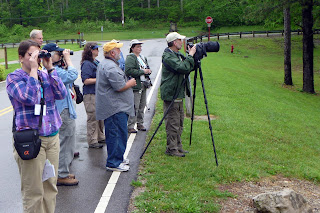This is Ruble Knob, within Shallenberger State Nature Preserve. These sandstone formations were shaped by water about 300 million years ago. You can follow the link above to read the geological history, or find a great guide to go along to tell you the story.
 |
| Jim Davidson, guide extraodinaire. |
The second stop this weekend was the annual Trillium Fest. It is held a few miles down the road from Lancaster, and offers one of the most spectacular hikes in all of the Hocking Hills. It is a part of the Appalachian Ohio Alliance (A.O.A.) Land Trust. They do some very good work, and I hope you will help support them.
 |
| Weedpicker in ski-gear in April? |
 |
| Large-Flowered Trilluim, Trillium grandiflorum |
The star of this spring flower show is always the Trillium. The Large-Flowered Trillium is our Ohio State flower and one of our most recognizable spring ephemerals.
 |
| Red Trillium, Trillium erectum |
But much rarer, and even more stunning is the Red Trillium. The name Red Trillium may not always seem accurate, as it can also be pink, or creamy white. Some call them Stinking Benjamin, as they have a rather unpleasant odor. It may be unpleasant to the nose, but what a sight for the eyes!
 |
| Red Trillium abound within this protected site. |
The sandstone formations are dotted in a floral Elysian and deserving of permanent protection. It is wonderful work for the ages, the people of A.O.A. are set about accomplishing. You'll find some of Ohio's best naturalists involved with this organization. No one speaks to their mission more clearly than our friend, Paul Knoop.
When we consider what it took to create this landscape, we must also consider what we can do to insure that future generations will also be able to marvel at its beauty.
Paul Knoop
It is no wonder good people like Jim Davidson and Paul Knoop continue to work towards the protection and preservation of Ohio's most beautiful and unique lands. Join the A.O.A and see how you can visit this property too.








































